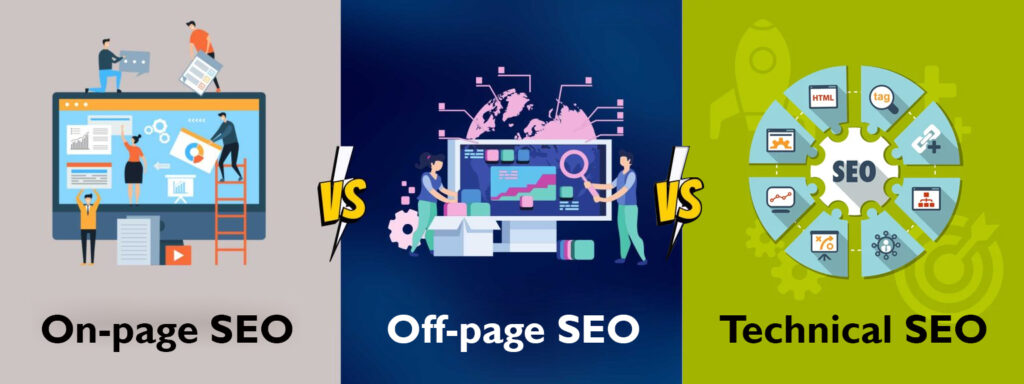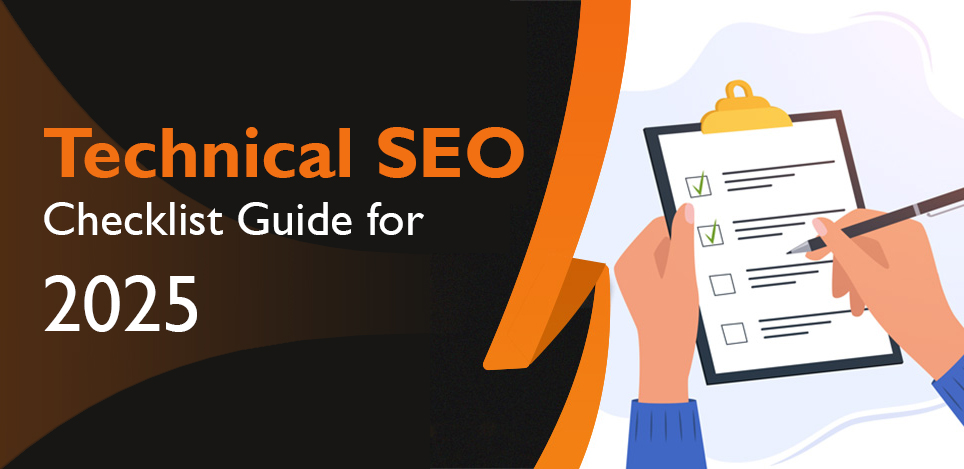Is your website truly prepared to keep up with Google’s ever-changing algorithms in 2025? If not, technical SEO can be the reason. Website SEO is no longer just a behind-the-scenes necessity, it is the foundation of every high-performing digital presence.
From seamless website crawling and indexing to Core Web Vitals optimization, technical SEO ensures your site is fast and ranks higher in search results. Whether you need to fine-tune your XML sitemap and robots.txt, boost your page speed, implement schema markup and structured data, or resolve issues like canonical tags and duplicate content, mastering technical SEO is non-negotiable.
Today, I am here to take you through a practical technical SEO checklist, break down the impact of the latest Google algorithm updates, and show you how to run effective SEO audits to improve your search engine ranking. So, without further ado, let us dive in and turn your website into a search engine powerhouse.
What is Technical SEO?

Technical SEO means improving the behind-the-scenes parts of your website so that search engines like Google can easily find, understand, and rank it. It focuses on things like page speed optimization, mobile-first indexing, using HTTPS to keep your website secure, and fixing broken links, ensuring your site performs better in search results.
Why Does Technical SEO Matter More in 2025?

Search engines are becoming smarter, faster, and more focused on user experience with every year. This clearly shows that having a strong technical SEO is no longer optional; it is essential. Here’s why technical SEO optimization matters in 2025
- It improves crawlability, allowing search engines to read your site.
- It boosts Google ranking with faster load times and a clean structure.
- It supports mobile-first indexing for better mobile performance.
- It enhances website security with HTTPS.
It fixes technical errors that block indexing or reduce visibility.
Technical vs On-Page vs Off-Page SEO: What’s the Difference?

To succeed with SEO, it’s important to understand the three main types of SEO. Here’s a breakdown of each type of SEO.
- Focus Area
- Technical SEO focuses on backend elements like page speed, mobile-first indexing, HTTPS, and crawlability.
- On-page SEO focuses on the quality of your content, keyword usage, titles, meta tags, and internal links.
- Off-page SEO focuses on external signals like backlinks, online reviews, and social media shares.
- Purpose
- Technical SEO helps search engines access, crawl, and index your site efficiently.
- On-page SEO helps search engines and users understand what your content is about.
- Off-page SEO helps build trust, credibility, and authority for your website across the web.
- Tools Used
- Technical SEO uses tools like Google Search Console and Screaming Frog to monitor site health.
- On-page SEO uses tools like Yoast, Surfer SEO, and Grammarly for optimizing content.
- Off-page SEO uses platforms like Ahrefs and Semrush to analyze backlinks and brand reach.
Technical SEO Checklist Guide for 2025

Now that you are familiar with the fundamentals of technical SEO, it’s time to dive into the ultimate SEO checklist that will keep your website optimized, crawlable, and ahead in the search engine rankings.
1. Crawlability & Indexing
The first on the list of step-by-step technical SEO checklist for website optimization is crawlability and indexing. If Google can’t properly access or understand your site, it significantly reduces your chances of ranking in search results.
What should you do?
- Submit and update your XML sitemap
- Ensure a clean robots.txt file
- Fix crawl errors using Google Search Console
- Identify and remove duplicate content with proper canonical tags
- Mobile-First Indexing
The second on the list of step-by-step technical SEO checklist is mobile-first indexing. Since Google now primarily uses the mobile version of your site for indexing and ranking, a responsive and consistent mobile experience is essential.
What should you do?
- Make sure your website is fully responsive on all screen sizes
- Use the same content and structured data on both desktop and mobile
- Avoid intrusive interstitials that affect user experience
- Test your site using Google’s Mobile-Friendly Test
- Page Speed Optimization
The third on the list of step-by-step technical SEO checklist is page speed optimization. This metric plays a crucial role in Google’s evolving ranking factors and algorithm updates. A fast-loading website enhances user experience and directly contributes to higher visibility and better rankings on search engines.
What should you do?
- Compress and optimize images
- Minify CSS, JavaScript, and HTML files
- Enable browser caching and Gzip compression
- Use Google PageSpeed Insights to monitor and fix speed issues
- Core Web Vitals Optimization
The fourth on the list of step-by-step technical SEO checklist is Core Web Vitals optimization. These metrics are part of the latest technical SEO trends and Google algorithm updates for 2025. These metrics help you understand how real users experience your website’s loading speed, interactivity, and visual stability.
What should you do?
- Improve Largest Contentful Paint (LCP) by optimizing main content loading
- Reduce First Input Delay (FID) by limiting JavaScript execution
- Minimize Cumulative Layout Shift (CLS) by reserving space for media and ads
- HTTPS and Website Security
The fifth on the list of step-by-step technical SEO checklist is implementing HTTPS and strengthening website security. A secure website builds user trust and is favored by Google.
What should you do?
- Install an SSL certificate to enable HTTPS
- Fix any mixed content issues
- Add security headers like HSTS and Content Security Policy (CSP)
- Structured Data & Schema Markup
The sixth on the list of step-by-step technical SEO checklists is structured data implementation. Schema Markup enhances how your pages appear in search results and helps search engines better understand your content.
What should you do?
- Add schema for articles, products, reviews, FAQs, etc
- Use JSON-LD format as recommended by Google
- Validate your markup using Google’s Rich Results Test
- JavaScript SEO & Rendering Optimization
The seventh on the list of step-by-step technical SEO checklist is JavaScript SEO and rendering optimization. If search engines can’t read your JavaScript content, your pages may not show up in search results.
What should you do?
- Use server-side rendering or dynamic rendering to show content clearly
- Make sure important content is visible without needing clicks or user actions
- Check how Google sees your page using the URL Inspection Tool in Search Console
- Delay non-essential JavaScript to help your page load faster
- Avoid hiding key content behind JavaScript
These are the core technical SEO aspects you must optimize to ensure your website is easily crawlable, user-friendly, and aligned with Google’s latest algorithms.
Best Technical SEO Practices for Higher Search Visibility
Following a checklist is a great start, but in 2025’s competitive digital landscape, it takes more to truly stand out. Here are some of the best technical SEO practices that will help you maximize your website’s visibility and performance in search results.
1. Avoid unnecessary URL parameters
2. Manage crawl budget by blocking unimportant pages
3. Use correct pagination with rel=prev and rel=next
4. Monitor and analyze server log files regularly
5. Create SEO-friendly 404 error pages
6. Use consistent URL structures
7. Keep plugins and CMS up to date
8. Regularly remove or update outdated content
9. Ensure fast and reliable website hosting
10. Use breadcrumb navigation
Future Trends in Technical SEO Beyond 2025

As we move beyond 2025, technical SEO is becoming more dynamic, personalized, and intelligent. Search engines are evolving to better understand human behavior, user intent, and real-time content performance.
Here are three key trends shaping the future of technical SEO:
- AI-Powered SEO Automation
The technical SEO trend you can notice is the role of AI and automation in technical SEO strategy. From detecting crawl issues and analyzing site speed to generating meta tags and optimizing for voice search, AI tools are making SEO faster and more accurate.
- Smarter Indexing Through Intent-Based Crawling
The second future trend reshaping technical SEO is intent-based crawling. Google is prioritizing pages that align with search intent, not just keyword usage. This means technical SEO needs to support structured data, semantic HTML, and optimized site architecture for better understanding.
- Real-Time Core Web Vitals Monitoring
The next key trend noticeable in technical SEO is monitoring real-time core web vitals. Instead of depending on occasional speed tests, websites are now using tools that continuously track user experience metrics like loading speed, interactivity, and visual stability as they happen.
Final Words
Technical SEO is no longer just a support system for content, it is the driving force behind search engine success. As algorithms evolve and user expectations rise, your website must be faster, cleaner, and smarter than ever. By mastering the elements discussed in this guide, you will not just optimize a site, you will build a digital asset ready for long-term growth.
Struggling with SEO or eager to stay ahead of the curve? Share your thoughts in the comments, or follow my guides for all the latest insights!
FAQs
- What are the mobile-first indexing and SEO practices in 2025?
Ans. Mobile-first indexing means Google primarily uses the mobile version of your website for ranking and indexing. In 2025, SEO best practices for mobile indexing include ensuring your site is fully responsive, having consistent content and metadata across desktop and mobile, and avoiding intrusive pop-ups.
- How to improve Core Web Vitals for better SEO performance
Ans. To improve Core Web Vitals, focus on optimizing your site’s loading speed, interactivity, and visual stability. Compress images, limit heavy JavaScript, reserve space for media and ads, and use tools like PageSpeed Insights for regular audits and fixes.
- How to fix crawl errors and indexing issues in Google Search Console?
Ans. To fix crawl errors and indexing issues, visit the “Coverage” or “Pages” report in Google Search Console to identify errors. Fix broken links, redirect 404 pages, update sitemaps, and use proper canonical tags. Then, request reindexing of fixed pages using the URL Inspection Tool.
- How to future-proof your website for long-term SEO success?
Ans. To future-proof SEO, focus on clean technical foundations, fast loading speeds, secure HTTPS protocols, mobile-first design, structured data, and staying updated with Google’s algorithm changes.
- How to optimize technical SEO for Google rankings in 2025?
Ans. Optimize technical SEO by improving crawlability, fixing indexing issues, enhancing Core Web Vitals, adding structured data, using HTTPS, and ensuring mobile responsiveness.
- How to optimize JavaScript-heavy websites for technical SEO?
Ans. To optimize JavaScript-heavy websites for technical SEO, use server-side rendering or dynamic rendering to ensure Google can crawl JavaScript content. Make sure critical content isn’t hidden behind interactions, delay non-essential scripts, and test with the URL Inspection Tool to see how Google renders your pages.

